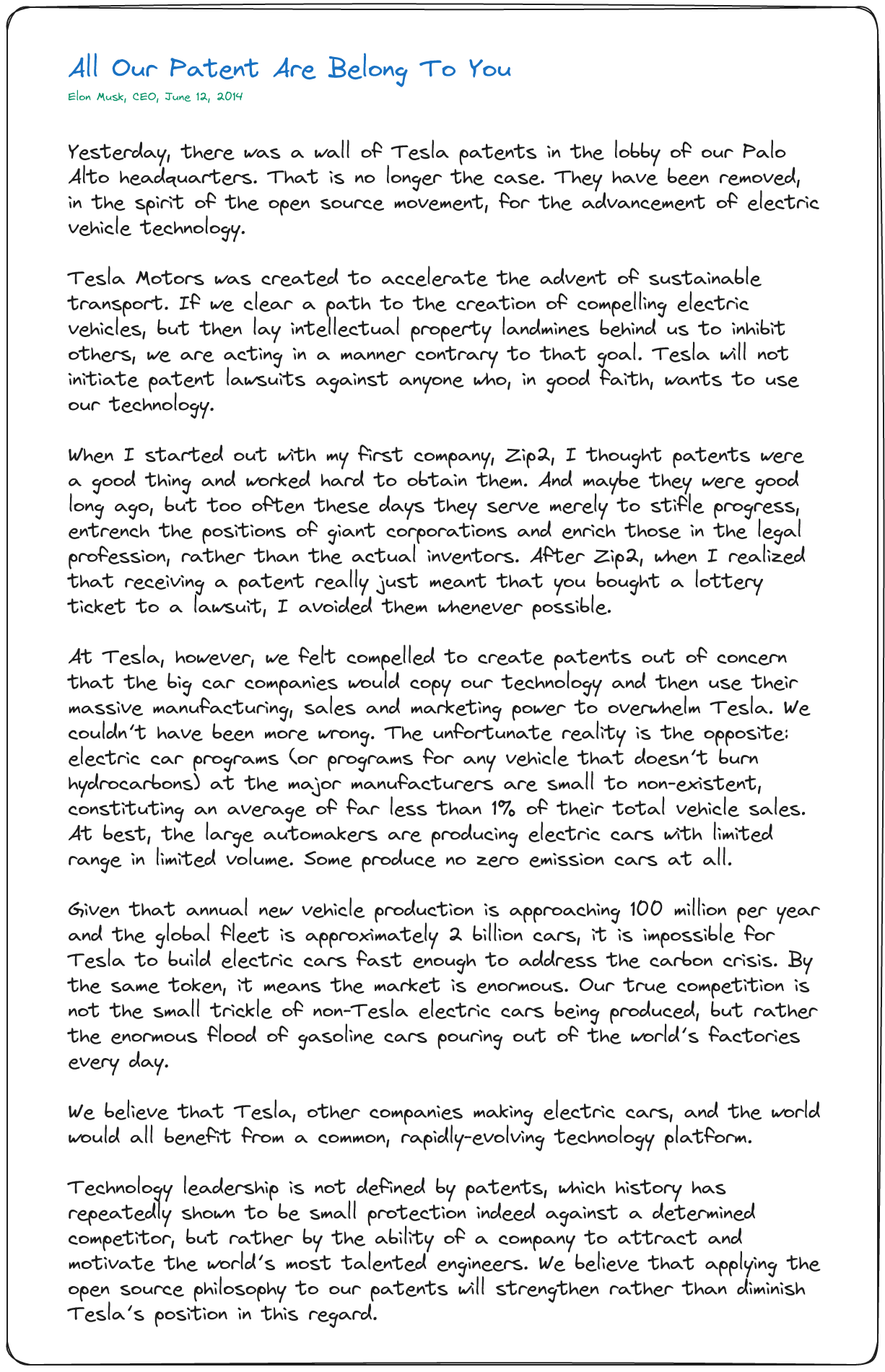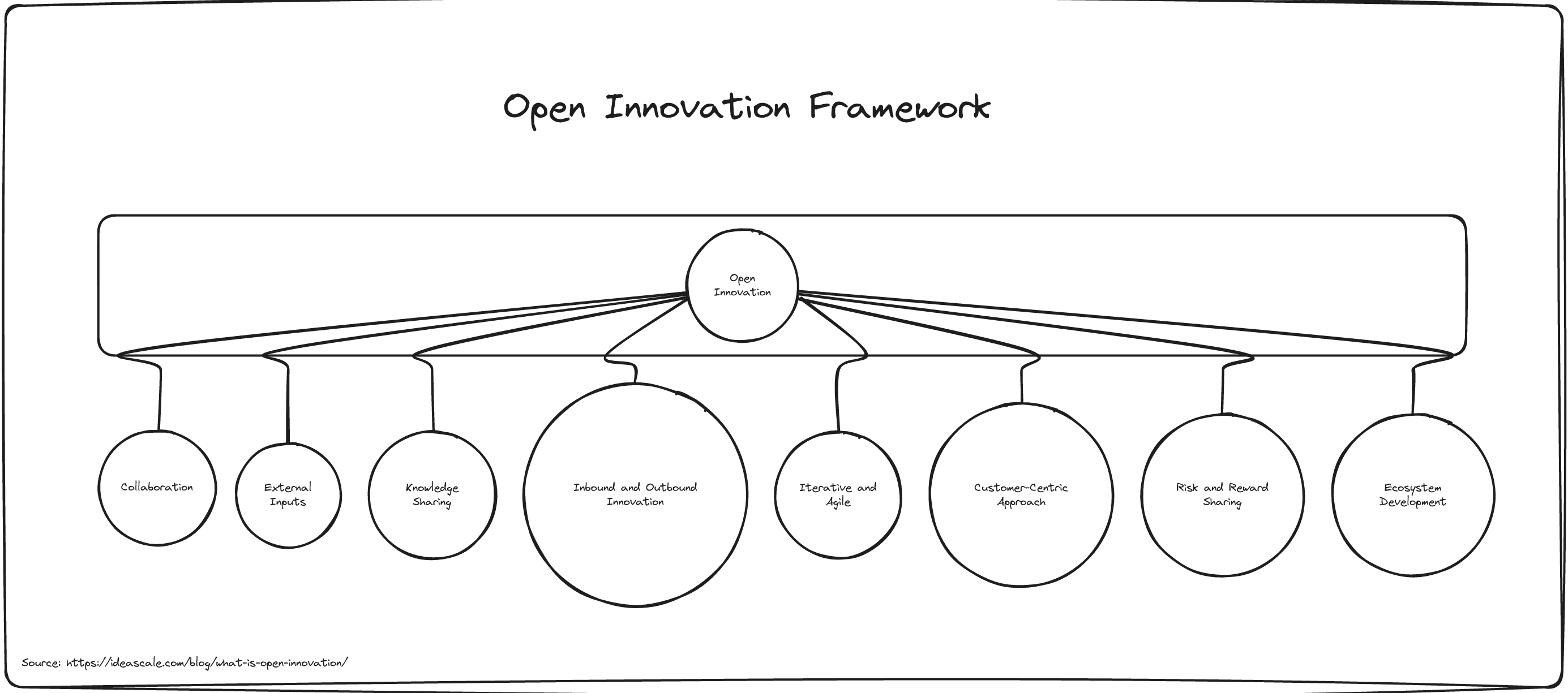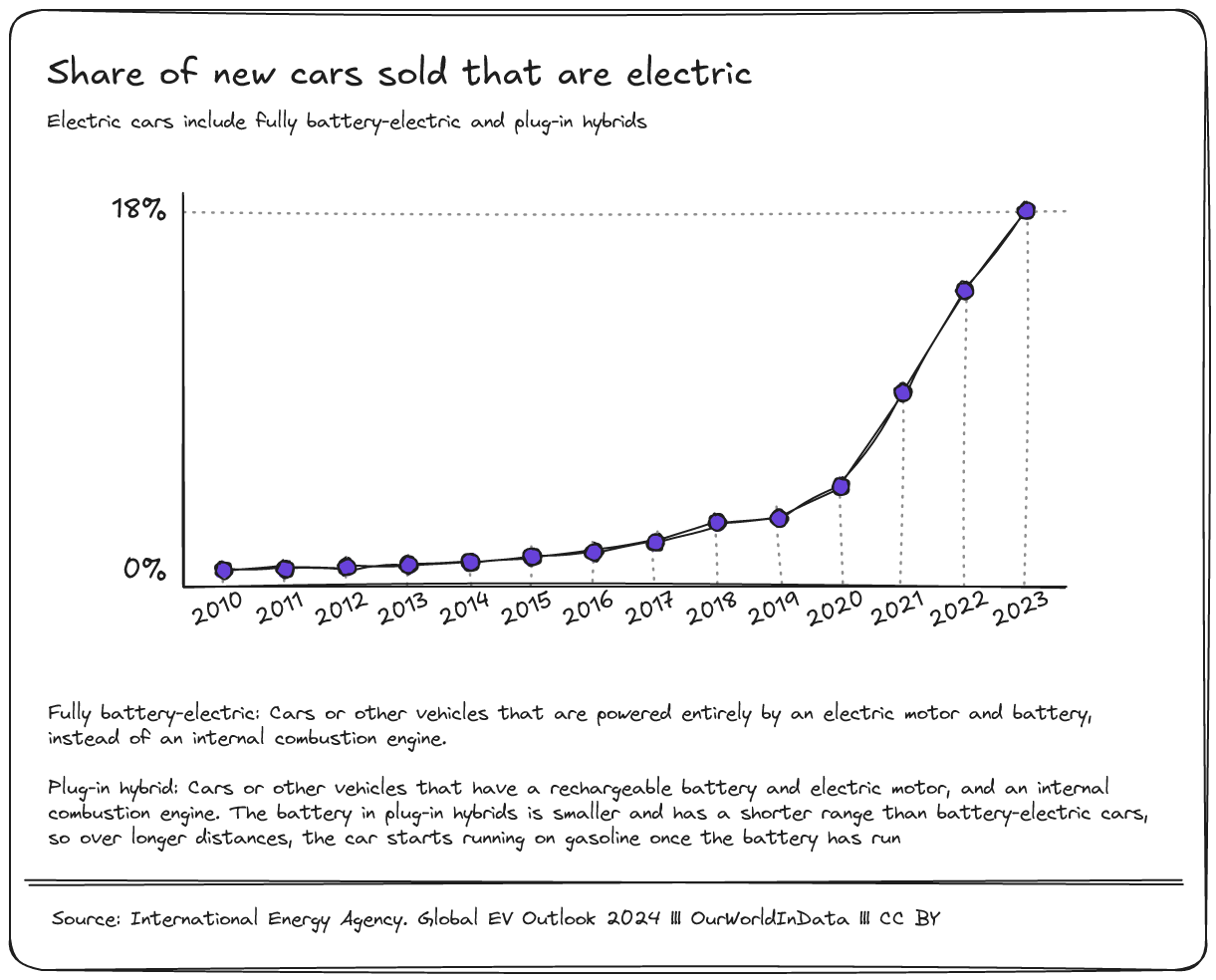Tesla's Open-Source Patent Strategy
In 2014, Tesla made a big decision to share its patents with everyone. This move, which allowed other companies to use Tesla’s technology without paying for it, surprised many in the industry. Let’s explore this decision through the lens of product management and strategy concepts, and see how it has affected the electric vehicle (EV) industry.
The Open Innovation Framework
Tesla’s decision is a prime example of the Open Innovation Framework. This framework suggests that companies can and should use both internal and external ideas to advance their technology and products. Let’s dive deep into how various product management and strategy concepts fit into this framework:
Open Innovation
Open innovation involves using external ideas and technologies alongside internal efforts to advance a company’s products and technology.
By sharing its patents, Tesla encouraged other companies to use and build upon its technology. This created a collaborative environment where multiple companies could contribute to advancing EV technology.
Ecosystem Strategy
An ecosystem strategy involves creating a network of interconnected products, services, and stakeholders that work together to deliver greater value than each could individually.
By opening its patents, Tesla promoted the development of a broader EV ecosystem. This includes charging infrastructure, battery technology, and other related products and services.
Network Effects
Network effects occur when the value of a product or service increases as more people use it.
As more companies adopt Tesla’s technology, the overall EV market expands. This increased adoption can lead to more charging stations, better battery technology, and more widespread acceptance of EVs, all of which benefit Tesla.
Competitive Strategy
Competitive strategy involves positioning a company to gain an advantage over its rivals.
While sharing patents might seem counterintuitive, it actually helps Tesla maintain its competitive edge. By setting industry standards and encouraging others to use its technology, Tesla remains at the forefront of EV innovation.
First-Mover Advantage
First-mover advantage refers to the benefits a company gains by being the first to enter a new market or adopt a new strategy.
As an early leader in the EV market, Tesla used its first-mover advantage to set industry standards. By sharing its technology, Tesla ensured its innovations would be widely adopted, reinforcing its leadership position.
Impact on the Electric Vehicle Industry
Tesla’s open-source strategy has had several significant impacts on the EV industry:
- By removing patent barriers, Tesla encouraged faster technological advancements in the EV sector.
- As more companies adopt Tesla’s technology, it could lead to more standardized components and systems across different EV brands.
- Open-source patents can lead to cost reductions for manufacturers, potentially making EVs more affordable for consumers.
- Tesla’s strategy has promoted the development of a broader EV ecosystem, including charging infrastructure and battery technology.
As an impact of open innovation strategy, there is an increase in the share of new electric cars sold globally. Let’s take a look at the below data.
The above data shows the growth of electric vehicle adoption. In 2014, when Tesla announced its decision to open-source its patents, electric vehicles accounted for just 0.41% of new car sales globally. Following this decision, we see a significant change in EV adoption. By 2018, four years after Tesla’s announcement, the share had increased nearly six-fold to 2.4%. The growth continued to accelerate, with EVs reaching 18% of new car sales in 2023 – a 44-fold increase from 2014.
While this growth can’t be attributed only to Tesla’s open innovation strategy, but it’s clear that the company’s decision to share its patents played an important role. By removing barriers to entry and encouraging collaboration across the industry, Tesla helped create an environment for rapid innovation and adoption of electric vehicle technology.
Other Examples
Tesla’s approach is part of a larger trend of open innovation across various industries:
Toyota: In 2019, Toyota shared nearly 24,000 patents related to its hybrid vehicle technology, aiming to promote the adoption of hybrid vehicles.
Levi Strauss: The company open-sourced its water-saving techniques for denim production, promoting sustainability in the apparel industry.
Nike: Nike shared several sustainability tools, encouraging other companies to create more environmentally friendly products.
Future Effects for Product Management and Strategy
The open innovation approach exemplified by Tesla could have far-reaching implications for product management and strategy, such as:
- Companies might increasingly collaborate with competitors and other stakeholders to develop products, particularly for complex technologies or when addressing global challenges.
- Product strategies may focus more on building and nurturing ecosystems rather than individual products, recognizing the value of interconnected products and services.
- Companies might seek competitive advantage through leadership in open innovation and ecosystem development, rather than solely through proprietary technology.
- Open innovation could lead to faster product development cycles as companies build upon shared knowledge and technologies.
- As seen with Tesla, Toyota, Levi’s, and Nike, open innovation might increasingly be used to address sustainability challenges, potentially becoming a key factor in product strategy.
In Conclusion, Tesla’s decision to open-source its patents is a bold application of the Open Innovation Framework. By using concepts like ecosystem strategy, network effects, and first-mover advantage, Tesla has positioned itself as a leader in the EV industry while potentially accelerating the global transition to sustainable transport.
This approach represents a shift in how companies might view intellectual property and competition in the future. Rather than guarding innovations, companies might increasingly see value in sharing them to drive industry-wide progress.
For product strategists, Tesla’s approach offers valuable lessons. It demonstrates the potential of open innovation to create value, drive adoption, and establish industry leadership. As industries evolve and global challenges persist, such collaborative approaches to product development and strategy might become increasingly common and crucial for success.
References:
- All Our Patent Are Belong To You
- Why Elon Musk Released Tesla’s Patents
- Tesla on Patents: Open Source Altruism or Shrewd Business?
- Does Tesla’s open source patent philosophy mean they are free to use?
- Considering Legal Implications of Open Sourcing Patents for Sustainable Vehicles
- Is Tesla’s Open Source Patent Strategy Implying That They Are Free To Use?



